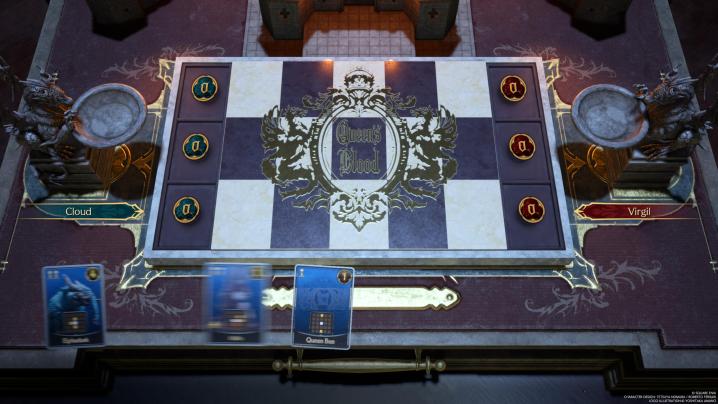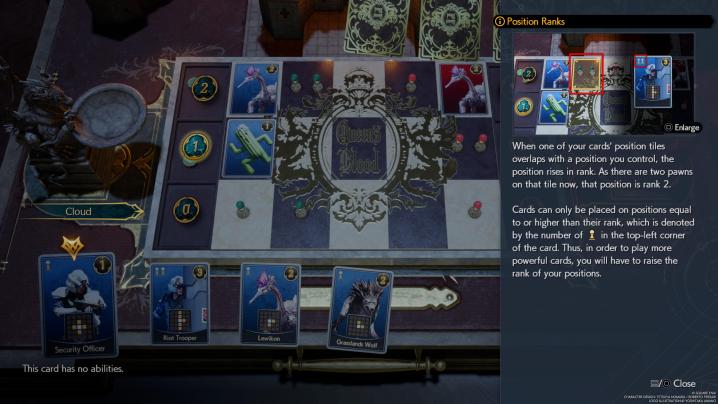After Fort Condor arrived in Final Fantasy 7: Remake Intergrade, you may not have expected an entirely new minigame to be introduced in Final Fantasy 7: Rebirth. However, after the opening hours, when you’re let loose in Kalm, you will automatically be given your very first deck of Queen’s Blood cards. While this minigame is entirely optional after you play your first game to learn the basics, you would be missing out on a ton of content and secrets, let alone fun, by ignoring it. Still, we understand if you feel you didn’t sign up for a strange new card game in your Final Fantasy adventure. Plus, there is a lot more depth to the game than is properly explained. If you want to rise up the ranks and be a Queen’s Blood champion, but are unsure how to start, we’ll show you the ropes.
The basics

The tutorial for Queen’s Blood does a decent job explaining the basic rules of Queen’s Blood, but it goes by rather quickly and may leave some things a little unclear until you play a few rounds.
The basic rules are to place your cards down on one of three rows. Each card has a strength value, a certain number of required pawns to place, and different configurations of tiles it affects. You and your opponent take turns placing cards until neither can play any more cards, at which point the strength totals for each row are compared. Whoever has the higher value in a given row gets that point total, while the other player gets none. If the strength totals are the same, neither player gets points. The player with the highest total after all three rows are resolved wins. For example, if you had 6 strength on the top row, 4 on the second, and 2 on the bottom and your opponent had 5, 5, 2 respectively, you would get 6 points from row one, 0 for two, and 0 for three due to a tie for a total score of 6. Your opponent would get 0 from the top, 5 from the second, and 0 from the bottom for a total of 5. Your 6 is greater than the opponent’s 5 and you would win the match.
In terms of playing cards, you need to consider the card’s strength, where it can be played, and what effect it has. We covered strength, but you also need to understand the required number of pawns a card needs to be played and how to increase them. You can only place cards on a tile marked with at least one pawn of your color. Playing cards with yellow effect squares will either create new pawn tiles in those spots or increase the number of pawns on a given spot if it overlaps with a space where you already have one or more pawns . Additionally, if that area overlaps with a tile an enemy has a pawn on, you can convert it to your pawn and keep them from playing there. Naturally, the same can be done to you.
Cards with higher strength and better abilities and zone of effect tend to only be playable on tiles with more than one pawn. You can always highlight a deck in your hand to see which, if any, tiles on the board that card can be played on. When hovering a card over a potential spot, you will also see exactly what effect it will have on the board before putting it down.
Best Strategies

With the basics under your belt, now comes the strategy. The rules are simple, but once you start getting into the game and seeing new cards, it can get rather complex. Before getting into deckbuilding tips, here are some more universal strategies to help you win those early matches.
The first is to take advantage of your redraw. You are able to choose one of the cards of your initial hand to shuffle for a new one before the game begins. While having a powerful card early may sound good, if it requires four turns to even create a space it can be placed on, so you’re better off throwing it back in your deck and getting something more immediately useful than having it as a dead card in your hand.
Your opening approach should balance pushing to claim territory with also trying to upgrade your existing spaces. You want to make sure you give yourself as much room to expand as possible, while not overextending to the point where you can’t play any cards that need two or more pawns on them to play. At the same time, reinforcing your area may leave you unable to get new cards on the table.
Be smart about which cards you prioritize playing and where. This comes down to a lot of factors you need to pay attention to, but the two most important are the current scores on each row and where on those rows you can place cards. For the former, there’s no point in placing a great card with a high power level to fill in the last spot on a row where it wouldn’t increase your score over the opponent’s score. Next is to be aware of where you place cards and in what order. If you have a claimed square in the top left of the board surrounded by other cards of yours, there’s very little risk of your opponent stealing it away. Rather than spend a turn putting a card there that also is unlikely to expand your current territory, save it for a later move and focus on taking more spaces and interrupting your opponent first.
Deck-building and card effects
You can go a long way in Queen’s Blood with the default deck. In fact, we won a tournament you will participate in during the story using exactly what is given to you at the beginning. But eventually, you need to improve your deck to keep up. If you don’t have the knack for deck-building, you can always rely on a few prebuilt options the game provides, so long as you have all the cards required to make them. Make sure you buy and collect as many cards as you can to test out these builds and see which you like. On the other hand, if you want to fully customize your deck, you are free to do so.
Finally, there are a few unique card effects you should know when picking or building a deck as denoted by the colored squares on each card.
- Yellow squares are the first you see and just add a pawn to the indicated squares.
- Red squares will reduce the strength of a card, friend, or foe in that square by a certain amount.
- Red outlines will buff cards in that space by a certain strength amount.
Editors’ Recommendations

